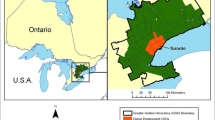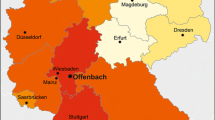Abstract
With 8.76 million residents in 2011, the population of Southern Ontario’s Greater Golden Horseshoe (GGH) has grown dramatically over the past decades, driven by net domestic in-migration and immigration. Corresponding to its growth in population, commuting distances and times within the region have grown as well. Yet, despite the number of immigrants that the region attracts on a yearly basis, there is comparatively little information on commute distances. Consequently, this paper examines commuting distance amongst immigrants in the GGH. Specifically, it evaluates commute distance by immigrant status (immigrants and native born), along with how commute distance differs by arrival cohort and ethnic and racial population groups. Results indicate that commute distance increases with increasing duration of residence, with differences by race and ethnicity.



Similar content being viewed by others
Notes
Strictly speaking, a somewhat smaller percentage of recent immigrants aged 25–54 engaged in the labour force as compared to native-born Canadians (63.5 %, compared with 82.9 %, respectively). http://www.statcan.gc.ca/daily-quotidien/121214/dq121214b-eng.htm.
Toronto’s commuter shed is defined as all census subdivisions (CSDs) surrounding the city where a minimum of 10 % of the working population commutes into any of the eight employment-rich CSDs of the GGH (see Fig. 1).
We do not attempt to maximize the explanatory power of the model (i.e., as expressed through the R-squared value), and are instead interested in the statistically significant relationships identified in the model. Geographically Weighted Regression techniques (GWR) may provide an alternate estimation method that improves the overall fit of the model.
See Axisa et al. (2012) for an in-depth description and definitions of the variables.
References
Alba, R.D., Logan, J.R., Stults, B.J.: The changing neighborhood contexts of the immigrant metropolis. Soc. Forces 79(2), 587–621 (2000)
Axisa, J., Newbold, K.B., Scott, M.: Migration, urban growth, and commuting distance in Toronto’s commute shed. Area 44(3), 344–355 (2012). doi:10.1111/j.1475-4762.2012.01097.x
Balakrishnan, T.R., Hou, F.: Socioeconomic integration and spatial residential patterns of immigrant groups in Canada. Popul. Res. Policy Rev. 18(3), 201–217 (1999)
Bauder, H.: ‘Brain abuse’ or the devaluation of immigrant labour in Canada. Antipode 35(4), 699–717 (2003)
Blázquez, M., Llano, C., Moral, J.: Commuting times: is there any penalty for immigrants. Urban Stud. 47(8), 1663–1686 (2010). doi:10.1177/0042098009356127
Blumenberg, E., Smart, M.: Migrating to driving: exploring the multiple dimensions of immigrants’ automobile use. In: Lucas, K., Blumenberg, E., Weinberger, R. (eds.) Auto Motives: Understanding Car Use Behaviours. Emerald Publishing Group Ltd., Bingley (2011)
Blumenberg, E., Song, L.: Travel behavior of immigrants in California: trends and policy implications. In: Transportation Research Board 87th Annual Meeting. Transportation Research Board, Washington (2008)
Bourne, L.S., Starkweather, S., Basu, R.: New People, New Places: Social Change in the Greater Toronto Region. NEPTIS Foundation, Toronto (2000)
Bourne, L.S., Bunce, M., Taylor, L., Luka, N., Maurer, J.: Contested ground: the dynamics of peri-urban growth in the Toronto region. Can. J. Reg. Sci. 26(2&3), 251–269 (2003)
Boyle, P., Cassidy, S., Duke-Williams, O., Rees, P., Stokes, G., Turner, A.: Commuting Patterns in Rural Areas. Countryside Agency, London (2001)
Cappe, M.: Starting on Solid Ground: The Municipal Role in Immigrant Settlement. Federation of Canadian Municipalities, Ottawa (2011)
Champion, T., Coombes, M., Brown, D.: Migration and longer distance commuting in Rural England. Reg. Stud. 42, 1–15 (2008)
Chatman, D.G.: Explaining the ‘‘immigrant effect’’ on auto use: the influences of neighborhoods and preferences. Transportation 41, 441–461 (2013). doi:10.1007/s11116-013-9475-4
Chatman, D.G., Klein, N.: Immigrants and travel demand in the United States: implications for transportation policy and future research. Public Works Manag. Policy 13(4), 312–327 (2009)
Clark, W.A.V., Huang, Y., Withers, S.: Does commuting distance matter? Commuting to lerance and residential change. Reg. Sci. Urban Econ. 33, 199–221 (2003)
Clark, W.A.V., Huang, Y.: Black and white commuting behavior in a large southern city: evidence from Atlanta. Geogr. Anal. 36(1), 54–68 (2004)
Crane, R.: Is there a quiet revolution in women’s travel? Revisiting the gender gap in commuting. J. Am. Plan. Assoc. 73, 298–316 (2007)
Crane, R., Takahashi, L.: Sex changes everything: the recent narrowing and widening of travel differences by gender. Public Works Manag. Policy 13, 328–337 (2009)
Ellis, M., Wright, R., Parks, V.: Geography and the immigrant division of labor. Econ. Geogr. 83(3), 255–281 (2007)
Ellis, M., Wright, R.: The industrial division of labour among immigrants and internal migrants to the Los Angeles economy. Int. Migr. Rev. 33, 26–54 (1999)
Findlay, A.M., Stockdale, A., Findlay, A., Short, D.: Mobility as a driver of change in rural Britain: an analysis of the links between migration, commuting and travel to shop patterns. Int. J. Popul. Geogr. 7, 1–16 (2001)
Green, A.: Employment opportunities and constraints facing in-migrants to rural areas in England. Geography 84(1), 34–44 (1999)
Green, A., Owen, D.: The Geography of Poor Skills and Access to Work. Policy Press, Bristol (2006)
Hanson, S., Pratt, G.: Job search and the occupational segregation of women. Ann. Assoc. Am. Geogr. 81, 229–253 (1991)
Hanson, S., Pratt, G.: Gender, Work, and Space. Routledge, London (1995)
Hiebert, D., Ley, D.: Assimilation, cultural pluralism and social exclusion among ethno-cultural groups in Vancouver. Urban Geogr. 24(1), 16–44 (2003)
Heisz, A., Schellenberg, G.: Public Transit Use among Immigrants, Catalogue Number 11F0019MIE—No. 224, Ottawa: Statistics Canada (2004)
Horner, M.A., Mefford, J.N.: Investigating urban spatial mismatch issues using jobs-housing indicators to model home-work separation. Environ. Plan. A 39(6), 1420–1440 (2007)
Hudson, M.: Modeling the probability of niche employment: exploring workforce segmentation in metropolitan Atlanta. Urban Geogr. 23, 528–559 (2003)
Jang, W., Yao, X.: Tracking ethnically divided commuting patterns over time: a case study of Atlanta. The Prof. Geogr. 66(2), 274–283 (2014)
Liu, C.Y.: Ethnic Enclave Residence, Employment, and Commuting of Latino Workers. J. Policy Anal. Manag. 28(4), 600–625 (2009)
Liu, C.Y., Painter, G.: Travel behavior among Latino immigrants: the role of ethnic concentration and ethnic employment. J. Plan. Educ. 32(1), 62–80 (2012)
Mathews, R.B., Simpson, R.J., Lorius, A., MacLeod, D., Sjogren, A.: The Growth Outlook for the Great Golden Horseshoe. Hemson Consulting, Toronto (2005)
McLafferty, S., Preston, V.: Gender, race and the determinants of commuting: New York in 1990. Urban Geogr. 16, 192–212 (1996)
Mercado, R.G., Páez, A.: Determinants of distance travelled with a focus on theelderly: a multilevel analysis in the Hamilton CMA, Canada. J. Transp. Geogr. 17, 65–76 (2009)
Myles, J., Hou, F.: Neighbourhood attainment and residential segregation among Toronto’s visible minorities. Analytical Studies Branch, Analytical Studies Research Paper Series No. 206. Statistics Canada Catalogue No. 11F0019MIE Ottawa: Statistics Canada (2003)
Newbold, K.B., Foulkes, M.: Geography and segmented assimilation: examples from the New York Chinese. Popul. Space Place 10, 3–18 (2004)
Preston, V., McLafferty, S., Liu, X.F.: Geographical barriers to employment for American-born and immigrant workers. Urban Stud. 35(3), 529–545 (1998)
Simmons, J., Bourne, L.S.: Living with population growth and decline. Plan Can. 47(2), 13–21 (2007)
Singer, A., Friedman, S., Cheung, I., Price, M.: The World in a Zip Code: Greater Washington, D.C. as a New Region of Immigration. Policy Report. Washington, DC: Brookings Institution (2001). Available on-line at http://www.brook.edu/es/urban/immigration/zipcode.htm
Smart, M.: A nationwide look at immigrant neighborhoods and mode choice. Transportation (2014). doi:10.1007/s11116-014-9543-4
Statistics Canada.: Commuting Distance (km) (9), Age Groups (9) and Sex (3) for the Employed Labour Force 15 Years and Over Having a Usual Place of Work of Canada, Provinces, Territories, Census Metropolitan Areas and Census Agglomerations, 2006 Census—20% Sample Data. http://www12.statcan.gc.ca/census-recensement/2006/dp-pd/tbt/Rp-eng.cfm?LANG=E&APATH=3&DETAIL=0&DIM=0&FL=A&FREE=0&GC=0&GID=0&GK=0&GRP=1&PID=90655&PRID=0&PTYPE=88971,97154&S=0&SHOWALL=0&SUB=0&Temporal=2006&THEME=76&VID=0&VNAMEE=&VNAMEF (2006)
Statistics Canada.: http://www12.statcan.gc.ca/nhs-enm/2011/dp-pd/prof/details/page.cfm?Lang=E&Geo1=CMA&Code1=535&Data=Count&SearchText=Toronto&SearchType=Begins&SearchPR=01&A1=All&B1=All&TABID=1 (2011)
Stoll, M.A.: Search, discrimination and the travel to work. In: Bobo, L., Oliver, M., Johnson, J., Valenzuela, A. (eds.) Prismatic Metropolis. Russell Sage, New York (2000)
Stoll, M.A.: Job Sprawl and the Spatial Mismatch between Blacksand Jobs. The Brookings Institution, Boston (2005)
Taylor, B., Ong, P.: Spatial mismatch or automobile mismatch? An examination of race, residence and commuting in US. Metropolitan Areas. Urban Stud. 32, 1453–1473 (1995)
Tal, G., Handy, S.: The Travel Behavior of Immigrants and Race/Ethnicity Groups: An Analysis of the 2001 National Household Transportation Survey. Institute of Transportation Studies, University of California, Davis, UCD-ITS-RR-05-24 (2005)
Wilson, F.D.: Ethnic niching and metropolitan labour markets. Soc. Sci. Res. 32, 429–466 (2003)
Acknowledgments
We would like to thank the editor (Prof. Mark Horner), the anonymous reviewers for providing insightful comments to improve our paper. The research was supported financially by a Grant from the Social Sciences and Humanities Research Council of Canada (410-2009-1402).
Author information
Authors and Affiliations
Corresponding author
Rights and permissions
About this article
Cite this article
Bruce Newbold, K., Scott, D.M. & Burke, C. Immigrant status and commute distance: an exploratory study based on the greater Golden Horseshoe. Transportation 44, 181–198 (2017). https://doi.org/10.1007/s11116-015-9633-y
Published:
Issue Date:
DOI: https://doi.org/10.1007/s11116-015-9633-y




